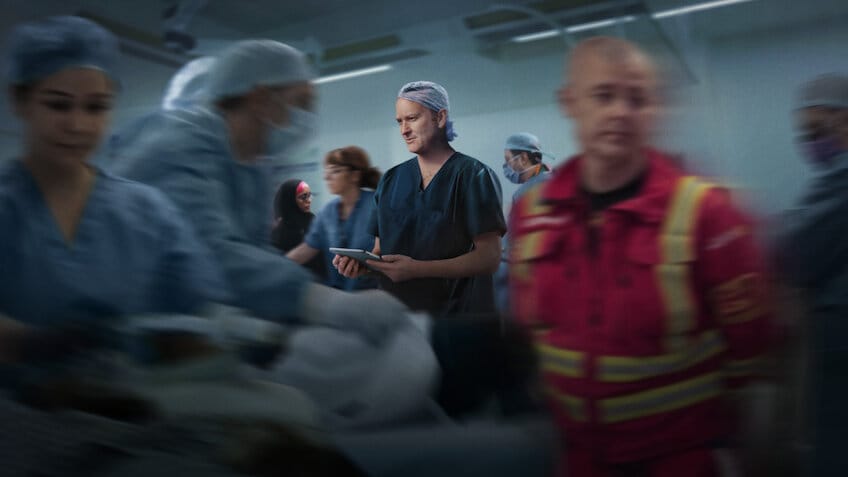A new documentary series offers an unprecedented and unfiltered look into the high-stakes world of London’s Major Trauma System. Titled Critical: Between Life and Death, the production comes from The Garden Productions, part of ITV Studios and the creative force behind the acclaimed series 24 Hours in A&E. This pedigree promises a distinct observational approach, prioritizing authentic human experience and institutional process over manufactured drama. Launched globally on Netflix, the series transcends entertainment, positioning itself as a significant piece of public documentation. It leverages the production team’s trusted reputation to deliver a definitive portrayal of the NHS to an international audience, suggesting a clear intent to chronicle the intricate workings of a vital public health institution.
An Unprecedented Look Inside an Integrated City-Wide Emergency Response
The sheer logistical scale of the production defines the series. Filmed over a concentrated 21-day period, the project deployed a network of 40 embedded cameras to capture its immersive, fly-on-the-wall perspective. This technological web spanned the entire London Major Trauma System, granting unparalleled access to its four key hospitals: Royal London Hospital, King’s College Hospital, St. Mary’s Hospital, and St. George’s Hospital. By weaving together stories from these distinct institutions, the series constructs a narrative not about a single hospital, but about the integrated system as a whole. The network of communication, transport, and specialized care becomes the true protagonist, elevating the concept of a coordinated, city-wide emergency response. The series makes a powerful case for the effectiveness of a centralized public healthcare infrastructure, shifting the focus from individual heroics to the complex, life-saving machinery of a unified system.
Following the Responders from the Streets to the Skies
The story begins long before the hospital doors, focusing extensively on the pre-hospital phase of care. The series follows dedicated clinicians from the London Ambulance Service and its advanced paramedic units as they answer the most urgent calls across the capital. Significant screen time is also devoted to the critical work of three distinct air ambulance charities: Essex & Herts Air Ambulance (EHAAT), London’s Air Ambulance, and Air Ambulance Charity Kent Surrey Sussex. These helicopter teams are shown responding to life-threatening incidents, delivering vital interventions at the scene, and rapidly transporting patients to major trauma centers. The prominent inclusion of these charities is notable, highlighting the UK’s hybrid model of emergency care where publicly funded services work in tandem with non-governmental organizations. The series powerfully illustrates the indispensable role these charities play within the state-run system, implicitly underscoring their reliance on public support to remain operational.
Real-Life Crises Captured with Unflinching Detail
The series documents a range of severe medical emergencies with unflinching realism. The first episode immediately establishes the stakes with a major incident: a fairground ride crash in Brockwell Park that left multiple people, including children, with serious injuries. Viewers are introduced to key personnel like Advanced Paramedic Rory Saggers, coordinating the response from a tactical operations center, and Flight Paramedic Nick Baxter and Advanced Paramedic Lara Hammond, who provided care amid the chaos at the scene. Opening with a complex, multi-patient event is a deliberate narrative strategy, grounding the series in a scenario of public concern while immediately demonstrating the system’s capacity to manage a large-scale crisis. Subsequent episodes delve into other critical cases, including the treatment of a motorcyclist with a limb-threatening open leg fracture and the care for a patient who sustained a serious head injury in an assault.
The Professionals at the Heart of the Trauma Centres
Inside the hospitals, the focus shifts to the senior clinicians navigating the decisions that define patient outcomes. The series puts a human face on the institution by introducing key medical leaders. Viewers meet Dr. Marie Healy, an ICU consultant and director of critical care at the Royal London Hospital, whose journey from training in Dublin to her current leadership role adds an international dimension to the story. Other featured experts include Mr. Ibraheim El-Daly, a Consultant Trauma and Orthopaedic Surgeon, and Dr. Malcolm Tunnicliff, the Clinical Director for Major Trauma at King’s College Hospital. By anchoring the narrative with these authoritative figures, who explain complex procedures and ethical dilemmas, the series builds credibility and humanizes the immense pressure of their work.
Documenting the Complete and Often-Traumatic Patient Journey
A defining characteristic of the series is its commitment to the entire patient journey, extending far beyond the initial emergency. The cameras go “under the scalpel” to document intricate surgical interventions and the subsequent intensive care. Crucially, the story doesn’t end with a successful operation. It continues to explore the long-term consequences of severe trauma, including the arduous process of recovery and rehabilitation. The series confronts the profound and permanent impacts these injuries can have, from lasting personality changes to permanent nerve damage. This holistic approach serves as a vital public education tool, countering the simplified “miracle cure” narratives of fictional dramas with a more realistic and sobering picture of what survival entails. It manages viewer expectations by illustrating the long, difficult, and sometimes incomplete nature of recovery, highlighting the sustained, resource-intensive care required long after the initial crisis has passed.
A Sobering Portrait of Life-and-Death Decisions
Ultimately, Critical: Between Life and Death is not entertainment, but a serious and consequential documentation of a vital public service. It offers a sober, unfiltered portrait of the clinical, personal, and emotional pressures that define the work of NHS frontline teams. The series gives viewers an intimate perspective on the moments where every second counts and the line between survival and death is at its thinnest. The cumulative effect is a powerful, evidence-based argument for the value of an integrated, publicly funded trauma network, delivered with journalistic rigor on a global stage. The six-part documentary series is available on Netflix. It premiered on July 23, 2025.























